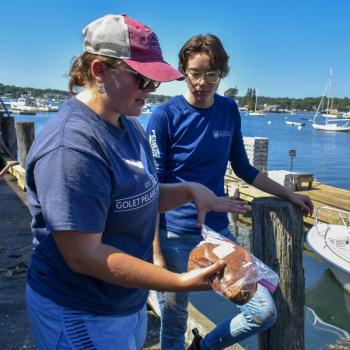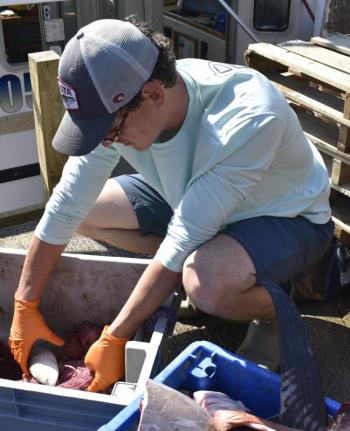While most eyes were glued on gargantuan fish during the Boothbay Harbor Tuna Challenge, some were focused on what’s inside. A team of researchers from the UMaine Pelagic Fisheries Laboratory gathered at Atlantic Edge Lobster to collect stomach, inner ear and other donated and discarded parts to better understand the fishery and inform the agencies managing it.
Based in Portland, the lab group samples fish caught across the Gulf of Maine. It’s part of the group’s stated aims to better understand highly migratory species in order to help improve management practices and reduce stock assessment uncertainties. For the scientists, tournaments represent a valuable opportunity to develop relationships with fishermen and collect high-quality samples otherwise unavailable.
“Being at tournaments, it's great because, when we're getting fish that we collect from dealers, which are also really valuable, we lack information like the weight of the fish, the full length of the fish. We're sometimes lacking stomach samples, liver samples. And being at tournaments, we can collect all of those things on site,” researcher Mackenzie O’Donnell said.
According to O’Donnell, researchers sample around 1,000 of the up to 6,000 tuna caught in the Gulf of Maine during the summer, including from tournaments and dealers. Like an autopsy, scientists can study different parts of the fish for insight into its life. Using the heads, they conduct genetic analyses and, when the whole fish isn't available, estimate its size. The inner ear bones, or otoliths, have seasonal bands that can tell age like tree rings. Researchers even can uncover where the fish spawned by using isotope analysis, a laboratory procedure that can match the fish to chemical patterns of water.
Combined with information from tag tracking, they can better understand fish habits. For example, management agencies accept that tuna hatcheries exist in either the Gulf of Mexico or Mediterranean Ocean according to lab manager Sammi Nadeau. It was once thought the fish didn't cross a line between the two, but she said scientists discovered that isn't the case by figuring out where fish came from and where they travel.
“We now have a better understanding that the two stocks do mingle quite a bit,” she said. “There is a substantial amount, and they're not to be treated as necessarily independent stocks.”
In fact, researcher John Carlucci said data suggests tuna may not spawn every year, opening up new lines of discovery. He said some go to either spawning ground, but others will stay in the Gulf of Maine or travel around the eastern seaboard. "I think the next question there is, ‘What are they doing there? Is it possibly a spawning ground?’ There are other proposed spawning grounds that haven't really been proven.”
Researchers also look inside fish stomachs to see what they have been eating, and livers to get a long-term picture of their diets. Nadeau said the information also provides insight into the changing foraging ecology in the Gulf of Maine. She said Atlantic herring have traditionally been a primary food, but pogies, or menhaden, are becoming a more prevalent meal. She said it suggests tuna are making use of the Gulf of Maine’s prolific foraging opportunities and adapting by switching to other lipid-rich species.
A large reason for the work is to inform agencies, such as the National Oceanic and Atmospheric Administration (NOAA), who manage the fisheries. Although the lab is not involved in management decisions, researchers said their work can help inform those making them. On a smaller scale, the information can be useful to fishermen. O’Donnell said one tuna that happened to be caught using squid had a lot of whiting in its stomach. So, she let the fisherman know he could switch.
“That's just a snapshot of what it's eaten probably within like a one to two-day digestion period. But it gives them an indication of maybe what to use for bait,” she said.
The anecdote is an example of small interactions that scientists say help build relationships with an industry that isn't always the most trusting of management or science. Nadeau said providing the samples isn't mandatory, and researchers have to ask fishermen essentially for their trash. In the process, they can talk about their work, the state of the fisheries and how their research can help. She said it’s led to some long-lasting, mutually beneficial relationships.
“A lot of other fisheries, there can be a lot of tension between the science and the fishing, but I think being able to come down too and just casually chat with people about what we're doing and why we're taking the samples also really helps because they learn stuff too,” Nadeau said. She later added that trust requires follow up on her end, too. “The fishermen understand that what they're doing and providing, there's a point to it and it is going somewhere. They're not just giving us heads and never hear about anything ever again.”



























.png)
.png)

